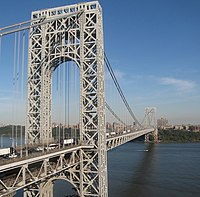![The 1915 Çanakkale Bridge on the Dardanelles strait in Turkey, connecting Europe and Asia, is the suspension bridge with the longest main span in the world.[1][2]](http://upload.wikimedia.org/wikipedia/commons/thumb/f/fc/1915_%C3%87anakkale_Bridge_20220327.jpg/240px-1915_%C3%87anakkale_Bridge_20220327.jpg) The 1915 Çanakkale Bridge on the Dardanelles strait in Turkey, connecting Europe and Asia, is the suspension bridge with the longest main span in the world.[1][2] | |
| Ancestor | Simple suspension bridge |
|---|---|
| Related | Underspanned suspension bridge; see also cable-stayed bridge |
| Descendant | Self-anchored suspension bridge |
| Carries | Pedestrians, bicycles, livestock, automobiles, trucks, railed vehicles |
| Span range | Medium to long |
| Material | Steel rope, multiple steel wire strand cables or forged or cast chain links |
| Movable | No |
| Design effort | medium |
| Falsework required | No |

A suspension bridge is a type of bridge in which the deck is hung below suspension cables on vertical suspenders. The first modern examples of this type of bridge were built in the early 1800s.[5][6] Simple suspension bridges, which lack vertical suspenders, have a long history in many mountainous parts of the world.
Besides the bridge type most commonly called suspension bridges, covered in this article, there are other types of suspension bridges. The type covered here has cables suspended between towers, with vertical suspender cables that transfer the live and dead loads of the deck below, upon which traffic crosses. This arrangement allows the deck to be level or to arc upward for additional clearance. Like other suspension bridge types, this type often is constructed without the use of falsework.
The suspension cables must be anchored at each end of the bridge, since any load applied to the bridge is transformed into tension in these main cables. The main cables continue beyond the pillars to deck-level supports, and further continue to connections with anchors in the ground. The roadway is supported by vertical suspender cables or rods, called hangers. In some circumstances, the towers may sit on a bluff or canyon edge where the road may proceed directly to the main span. Otherwise, the bridge will typically have two smaller spans, running between either pair of pillars and the highway, which may be supported by suspender cables or their own trusswork. In cases where trusswork supports the spans, there will be very little arc in the outboard main cables.
- ^ "Why Turkey Built the World's Longest Suspension Bridge". The B1M. 11 May 2022. Retrieved 22 May 2022.
- ^ "Groundbreaking ceremony for bridge over Dardanelles to take place on March 18". Hürriyet Daily News. 17 March 2017. Retrieved 22 May 2022.
- ^ "Port Authority of New York and New Jersey - George Washington Bridge". The Port Authority of New York and New Jersey. Archived from the original on 20 September 2013. Retrieved 14 February 2023.
- ^ Bod Woodruff; Lana Zak & Stephanie Wash (20 November 2012). "GW Bridge Painters: Dangerous Job on Top of the World's Busiest Bridge". ABC News. Archived from the original on 28 September 2013. Retrieved 14 February 2023.
- ^ Chakzampa Thangtong Gyalpo – Architect, Philosopher, and Iron Chain Bridge Builder Archived 25 May 2014 at Wikiwix by Manfred Gerner. Thimphu: Center for Bhutan Studies 2007. ISBN 99936-14-39-4
- ^ Lhasa and Its Mysteries by Lawrence Austine Waddell, 1905, p.313